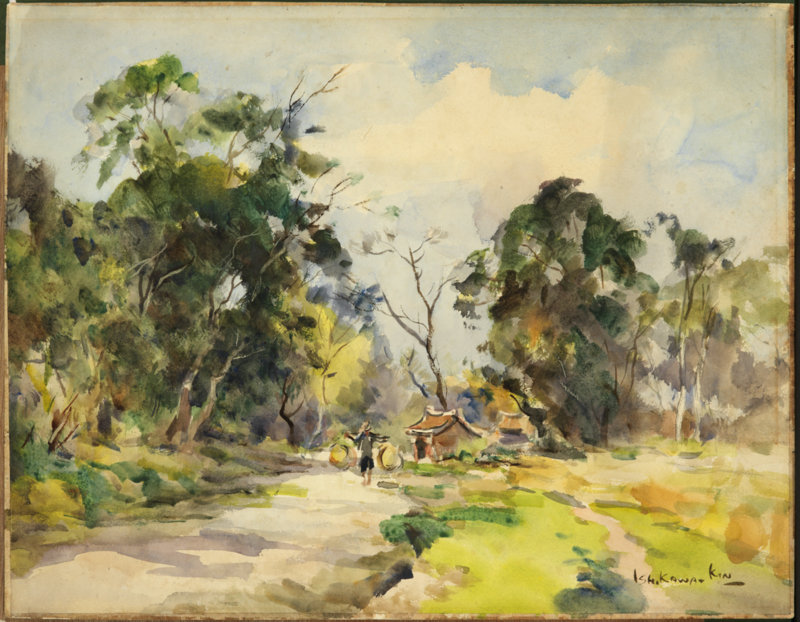Short bio
Ishikawa Kinichiro
1871.08.08~1945.09.10
Birthplace / Shizuoka City , Japan
Ishikawa Kinichiro, a watercolor painter and champion of Taiwanese Western art education, was born in Fukuoka, Japan. His father was a former official of the Tokugawa government during the bakumatsu (late Tokugawa Shogunate). He was infatuated with painting from a very early age, but his father did not approve of his artistic pursuits.
In 1888, he entered the Tokyo Telecommunications School of the Ministry of Communications. In order to sustain his interest in painting, aside from using prints of English works to engage in self-study, he also studied Western paintings under Shoudai Tameshige. In 1889, he entered the Ministry of Finance’s Printing Department and joined the Meiji Fine Art Society. He traveled, with the English watercolor painter Alfred East (1849-1913) acting as his Japanese language translator, and this experience inspired his interest in watercolors. By 1906, he began to publish essays in the watercolor magazine "Mizue" (Water Painting).
Due to his proficiency in the English language and his painting ability, Ishikawa worked as an official translator of the Imperial Japanese Army General Staff Office. In 1900, he left for China as a result of the Boxer Rebellion and, from 1904 to 1905, he was stationed in Manchuria during the Russo-Japanese War. While engaged at various military posts, he had several opportunities to draw battlefield scenes.
In 1907, he visited Taiwan for the first time as a military translator for the Taiwan Governor-General’s Office. From 1910 onwards, he served as an instructor at Taiwan Governor-General's National Language School’s Painting Division. In 1913, he organized other Japanese literatiin Taiwan to form the Bancha Society and promote cultural activities in Taiwan.
By 1916, he resigned his teaching position and returned to Japan to paint en plein air while traveling and hosting exhibitions. In 1922, he fulfilled a longstanding wish, traveling to Europe and painting en plein air at places such as Paris, London, Rome, and Venice. In 1923, his home in Kamakura was destroyed during the Great Kantō earthquake, indefinitely shutting down his art activities.
In 1924, at the invitation of Taipei Normal School’s Dean Shihota Syōkichi, Ishikawa returned to Taiwan to teach once again. He continued teaching in Taiwan until his retirement in 1932, and then went back to Japan. During Ishikawa’s second sojourn in Taiwan, he actively promoted both watercolor and other fine art activities.
Aside from teaching formal classes, he also organized and led en plein air painting field trips on holidays. He advised several art groups, such as the Chi-Hsing Painting Society, Taiwan Watercolor Painting Society, Keelung Asia Art Society, and Taiwan Painting Studio. In addition, along with other artists such as Shiotsuki Toho and Gohara Koto, he participated in the planning and judging of the 1st Taiwan Art Exhibition (Taiten). At the same time, he published many articles and other works in publications such as Taiwan Nichinichi Shimpo, The Taiwan Times, and Taiwan Education. He also published Scenic Beauties Collection and Extracurricular Painting Guides.
His contributions to the promotion and development of Taiwan art education were held in high esteem. Many students, such as Ni Chiang-huai, Lan Yinding, Li Chefan, and Chen Zhiqi, received help and inspiration from Ishikawa. Ishikawa Kinichiro traveled throughout Taiwan to compose en plein air paintings, and many of his works depict the natural scenery and historical monuments of the island. His brushwork was light and agile, colors were bright and appealing, and he had a distinctive style of capturing pastoral scenes in a romantic, nostalgic atmosphere. Taiwan’s Acacia, Zhantan trees (Melia azedarach), and old houses were often the subjects of his paintings.
http://chenchengpo.asdc.sinica.edu.tw/index

石川欽一郎: The Old Path at Fengyuan 豐原舊道. 30×39.3 cm. 順益台灣原住民博物館
http://catalog.digitalarchives.tw/item/00/60/7f/24.html
